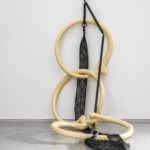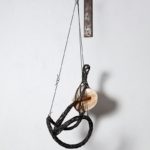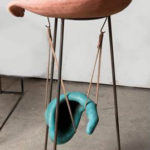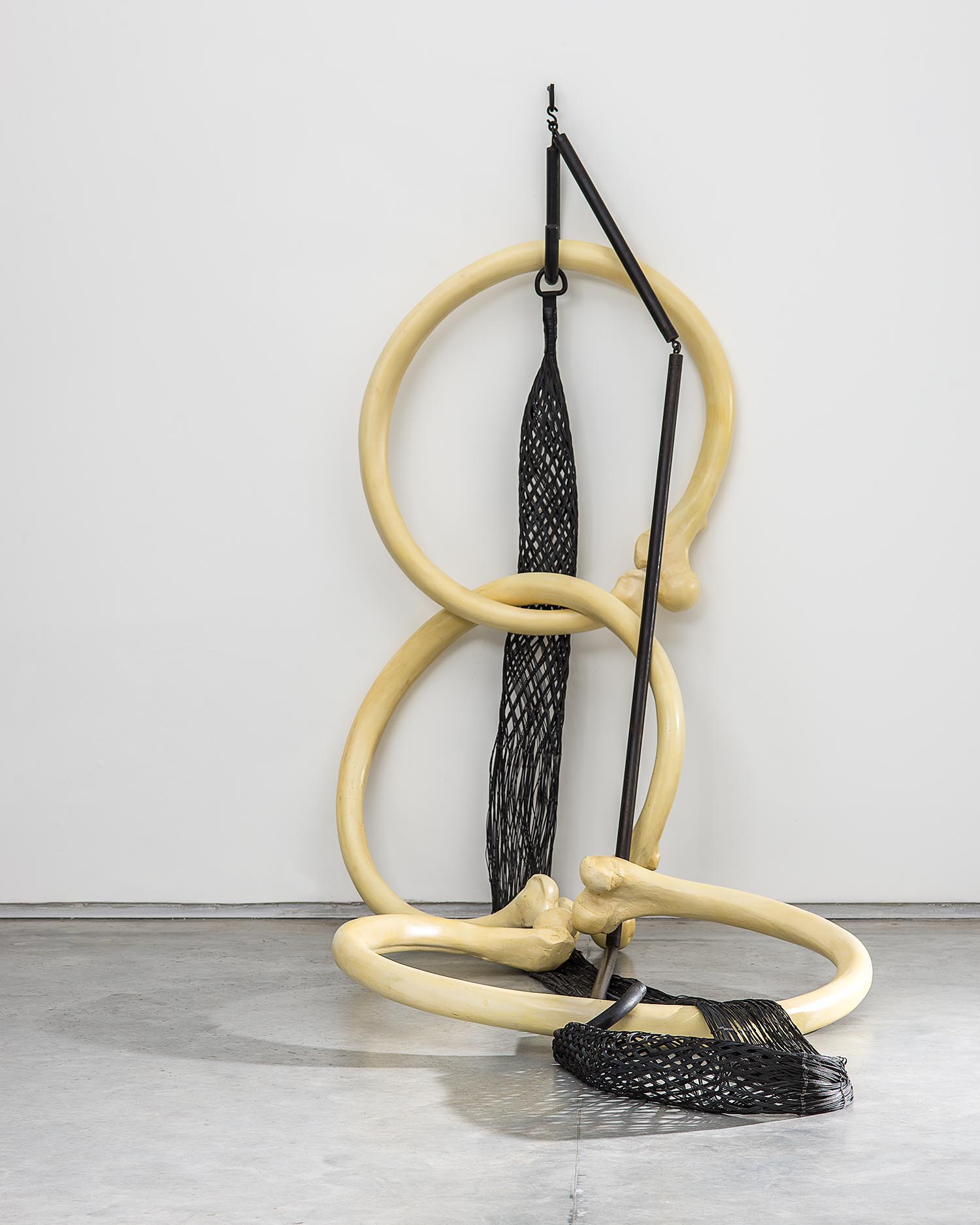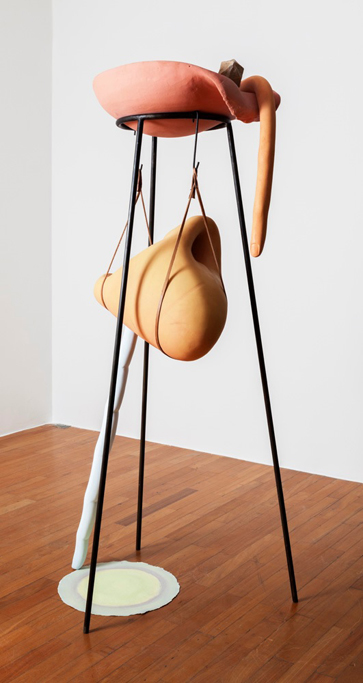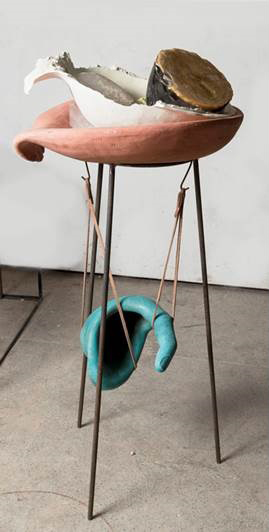Graduated as an architect, his plastic-visual work integrates several areas of knowledge in a permanent investigation on the areas of biological and exact sciences, emcompassing literary, artistic, philosophical and scientific references, including in this research archeology, paleontology, psychoanalysis , zoology, medicine, using with this diversity an immense accumulation of materials, where common objects – yarns, glasses, wool, felt, bones, needles and more – are transformed by their use to create an innovative, instigating and fantastic universe between the realms of the real and the imaginary. This creation brings to life a work that has become an aesthetic project, personal and unique by his drawings, sculptures, installations, performances, videos, and photos, becoming an image inventor and creator with his astonishing artwork.
Tunga (Antonio José de Barros Carvalho e Mello Mourão) was born in Palmares, Pernambuco, in February 8, 1952. He moved to Rio de Janeiro in 1974, where he has completed the Architecture and Urbanism course at Universidade Santa Úrsula. In 1987, Arthur Omar created the O Nervo de Prata film, about his work. Winner of several awards, among others, we have: Brasília de Artes Plásticas, in 1990; Mário Pedrosa Award, in 1991, from Associação Brasileira de Críticos de Arte for his work Preliminares do Palíndromo Incesto; Latin American Triennale, from 1986, de arte sobre papel, Buenos Aires, Argentina; 1997, Museu de Arte Moderna da Bahia; nominated for awards such as Hugo Boss Award, Guggenheim Museum, New York and Artes Mundi Preize, in Wales, United Kingdom. With exhibitions in several countries, works in national and international collections, he has participated, among others, in the biennials of Venice, São Paulo, Havana and Documenta in Kassel, Germany. His works are in permanent collections of museums like the Guggenheim, from Venice, Italy, or in a gallery dedicated to his work in the Institute Inhotim. He was the first contemporary artist and the first Brazilian to have a work exhibited at the Louvre Museum in Paris, France. He passed away in Rio de Janeiro, in June 6, 2016.
Your artwork has a strong relationship with the world through artistic, literary, and scientific sources. How do you manage to perform this integration within the limits of visuality?
I believe the poet’s and artist’s task in the world today, is to carry scattered sensibilities in the most diverse knowledge society is able to produce. The artist is a sort of worldwide general practitioner eye, pointing to possible spirit formations.
Your work includes drawings, sculptures, installations, performances, videos and photos, resulting in a relationship with the world, for creation and visualization. How are these paths, or some of them, selected or chosen for being performed/executed? Is there a project?
Yes, there is a project, a program. Every artist should have their program, their schedule. One way treats it in a more conscious manner, another in a more instinctive one. To elucidate expressing this program is the development of the work. During this period that the program takes place, it becomes clear. To understand this program, it seems to me, is to bring it to consciousness, where it can operate the navigation of the most diverse languages without losing track. Like a general practitioner, it is necessary to look at the whole body and the interrelations between the parts and organs. Suppose this body manifests itself by words, colors, sounds, tastes, forms, temperatures, odors… To combine the languages dealing with these senses, reconstructing a possible body, will be one of the goals of this project.
From the relationship with the world to the development, your work has an interactive dimension with the “audience”. Becoming a participant, the “audience” is asked to stop having a static apprehension, and having an relationship expression instead?
Looking is already participating! Tasting a spice is participating as well. What has been offered in the current art is a greater integration with what was proposed by the artist. The artist stands as the commander of a boat where he is also a passenger as the audience. The route of a work is created by the captain’s ability to navigate with the crew, to figure out how to take the boat to “seas never before sailed.” To achieve this, integration with the audience in this program is fundamental; the artwork should therefore invite the audience to the proposed trip.
About this relationship, what is the limit between virtual and real in your artwork?
It is the neural limit, as far as we can go…
The use of materials, the diversity of them, and the use of light – such as infrared, ultraviolet – as a material, also stands out in your work. This materiality of light gives us a certain lightness. Can you discuss the choice, the use, how your research is carried out, and how it radiates in your creation? What is the juxtaposition of materials in your creation?
The very idea of “material” of work, building material, makes us think of architecture, and an efficient architect takes into account the dawn and the sunset, the winds, calms, borders, implantations, fixation and displacements … Everything is susceptible of becoming building material. The density and complexity creative factor of a work will be the attention to all this. What you call lightness is perhaps the diversity of entries the artwork proposes.
Another thing that stands out in your work is space, the dialogue performed between mass and volume, background and figure, and above all, what is accomplished by emptiness. How do you see the space in your work? And how about the relation between corporeity and emptiness?
Everything seems to be bodies to me, there is no emptiness in my view, there are densities: subtle, transparent, ethereal or charged, saturated, heavy, and so on.
Your work has a formal sophistication to it. Is this preceded by a graphic design? In fact, what is graphic design for the accomplishment of your work?
Graphic is drawing. Most works are not born from drawings, although it is an instrument, a tool for improvement and construction of the pieces. They are born from a sort of fog, which expresses itself in one direction or another with more intensity. The repercussion of this fog for me is that it will privilege formalization in this medium or the other. They could have been a song if my musical aptitudes were more accurate. If that’s the case, I can count with musical colaborators, which will guide me in the creation of the desired song.
One of the critics who accompany your work claims that you regard sculpture as a set of enigmatic forms and figures whose strategy and fabulous proportions integrate the viewer and cause disturbance in their usual perception of near and far, inside and out, full and empty. Is this one of the goals from your artwork?
Yes.
In your relationship with the arts, the sciences and literature, the presence of psychology, the interest in the unconscious, in the dream, in the construction, stands out. It may extend to biology as well. Do these studies serve to what extent to the development of your work?
Diverse hermeneutics are attractive to me. To show, to create something and its versions. Have the version of the facts of others and other facts raised by the creation. In this consists psychoanalysis, literary theory, etymology, even dentistry. They all create versions for facts which contribute to a more poetic view of the world. The poetry uses these versions in a “perverse” way.
While choosing your material, you own them, you take their nature out of them, and with their “infection”, the artwork is born. Can this juxtaposition of materials, with the origin being modified, also be translated to the viewer? Does the work creates a new world for its universe? Still on this topic: Do this change also must cause a symbolic change? Perhaps create a symbolic? A new vision? Does your work demand a new vision to be appreciated?
To construct with the audience a special poetics that is both mine and theirs, being able to rescue, in the primary processes, a world in transformation, a world transformable by us.
(Interview/March, 2008)


